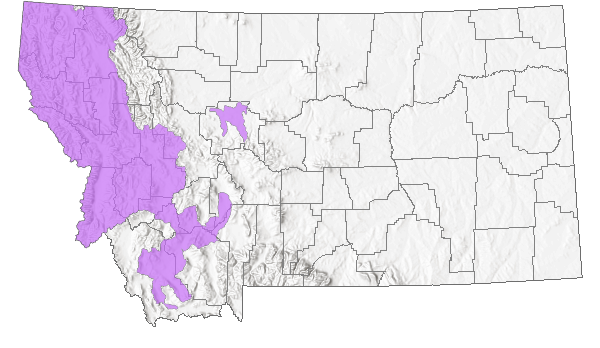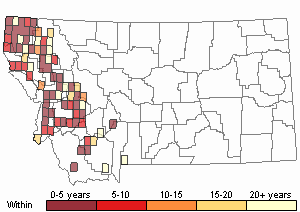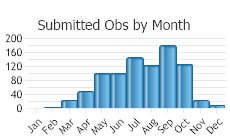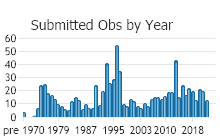View in other NatureServe Network Field Guides
NatureServe
Montana
Utah
Wyoming
Idaho
Wisconsin
British Columbia
South Carolina
Yukon
California
New York
Redside Shiner - Richardsonius balteatus
Native Species
Global Rank:
G5
State Rank:
S5
(see State Rank Reason below)
Agency Status
USFWS:
USFS:
BLM:
External Links
State Rank Reason (see State Rank above)
Species is distributed across western Montana and populations appear to be stable. Threats are poorly understood
General Description
The redside shiner is native to Montana west of the Divide and has been introduced into our eastern drainage, probably by bait fishermen. It likely was given its common name because red develops on its sides during the breeding season. The preferred habitat of this fish is cold, clear ponds, lakes and the slow water of streams. It can often be found in schools. The largest redside shiners are about 7 inches long. Populations of these fish can reach nuisance proportions in the lakes of western Montana.
Diagnostic Characteristics
Dark olive to brown on back; dark midside band from snout to tail fin with a narrow light stripe above it; lower sides silver with a reddish wash; underside silvery. Breeding fish highly colored; male has brilliant red and yellow on sides and belly, female is less striking. Body moderately deep and flat sided, front of dorsal fin well behind front of pelvic fins.
Species Range
Montana Range
Range Descriptions

 Native
Native
Western Hemisphere Range

Observations in Montana Natural Heritage Program Database
Number of Observations: 895
(Click on the following maps and charts to see full sized version)
Map Help and Descriptions
Relative Density

Recency



 (Observations spanning multiple months or years are excluded from time charts)
(Observations spanning multiple months or years are excluded from time charts)
Habitat
Lakes, ponds, and larger rivers where current is weak or lacking (Brown 1971).
Food Habits
Young feed mainly on plankton and adults eat mostly aquatic insects and snails (Brown 1971).
Ecology
Important forage fish for salmonids. Redside small shiner x peamouth and Redside small shiner x Northern pikeminnow hybrids have both been found in Montana.
Reproductive Characteristics
Sexually mature in 2-3 yrs. Usually spawns June-July but may spawn as early as may and as late as August. Spawns in schools (Brown 1971).
Stewardship Responsibility
References
- Literature Cited AboveLegend:
 View Online Publication
View Online Publication Brown, C.J.D. 1971. Fishes of Montana. Bozeman, MT: Big Sky Books/Montana State University. 207 p.
Brown, C.J.D. 1971. Fishes of Montana. Bozeman, MT: Big Sky Books/Montana State University. 207 p. Lee, D.S., C.R. Gilbert, C.H. Hocutt, R.E. Jenkins, D. E. McAllister, J. R. Stauffer, Jr. 1980. Atlas of North American freshwater fishes. North Carolina State Musuem of Natural History. 867 p.
Lee, D.S., C.R. Gilbert, C.H. Hocutt, R.E. Jenkins, D. E. McAllister, J. R. Stauffer, Jr. 1980. Atlas of North American freshwater fishes. North Carolina State Musuem of Natural History. 867 p. Scott, W.B. and E.J. Crossman. 1973. Rainbow trout, Kamloops trout, Steelhead trout Salmo gairdneri Richardson. pp. 184-191. In: Freshwater fishes of Canada. Ottawa, Canada: Fisheries Research Board of Canada, Bulletin 184. 966 p.
Scott, W.B. and E.J. Crossman. 1973. Rainbow trout, Kamloops trout, Steelhead trout Salmo gairdneri Richardson. pp. 184-191. In: Freshwater fishes of Canada. Ottawa, Canada: Fisheries Research Board of Canada, Bulletin 184. 966 p.
- Additional ReferencesLegend:
 View Online Publication
View Online Publication
Do you know of a citation we're missing? Barnard, D. and J. Vashro. 1986. ASARCo Rock Creek project, baseline fisheries assessment. MTFWP Report under contract to ASARCo. 22 p.
Barnard, D. and J. Vashro. 1986. ASARCo Rock Creek project, baseline fisheries assessment. MTFWP Report under contract to ASARCo. 22 p. Brandt, Troy M. 2000. Fish diversity behavior and microhabitat use in secondary channels of the Bitterroot River, Montana. M.S. Thesis. University of Montana. Missoula, MT.
Brandt, Troy M. 2000. Fish diversity behavior and microhabitat use in secondary channels of the Bitterroot River, Montana. M.S. Thesis. University of Montana. Missoula, MT. Jones, Thomas S. 1991. Floodplain distribution of fishes of the Bitterroot River with emphasis on introduced populations of Northern Pike. M.S. Thesis. University of Montana. Missoula, MT.
Jones, Thomas S. 1991. Floodplain distribution of fishes of the Bitterroot River with emphasis on introduced populations of Northern Pike. M.S. Thesis. University of Montana. Missoula, MT. Joslin, Gayle, and Heidi B. Youmans. 1999. Effects of recreation on Rocky Mountain wildlife: a review for Montana. [Montana]: Montana Chapter of the Wildlife Society.
Joslin, Gayle, and Heidi B. Youmans. 1999. Effects of recreation on Rocky Mountain wildlife: a review for Montana. [Montana]: Montana Chapter of the Wildlife Society. Nelson, M.L. 1999. Evaluation of the potential for resident bull trout to reestablish the migratory life-form. M.Sc. Thesis. Bozeman, MT: Montana State University. 72 p.
Nelson, M.L. 1999. Evaluation of the potential for resident bull trout to reestablish the migratory life-form. M.Sc. Thesis. Bozeman, MT: Montana State University. 72 p. Poole, A.S. 2019. Evaluation of embryo suppression methods for nonnative Lake Trout in Yellowstone Lake, Yellowstone National Park, Wyoming, USA. M.Sc. Thesis. Bozeman, MT: Montana State University. 108 p.
Poole, A.S. 2019. Evaluation of embryo suppression methods for nonnative Lake Trout in Yellowstone Lake, Yellowstone National Park, Wyoming, USA. M.Sc. Thesis. Bozeman, MT: Montana State University. 108 p. Rahrer, J.F. 1963. Age and growth of four species of fish, Flathead Lake, Montana. M.Sc. Thesis. Bozeman, MT: Montana State University. 16 p.
Rahrer, J.F. 1963. Age and growth of four species of fish, Flathead Lake, Montana. M.Sc. Thesis. Bozeman, MT: Montana State University. 16 p. Reinhart, D.P. 1990. Grizzly bear habitat use on cutthroat trout spawning streams in tributaries of Yellowstone Lake. M.Sc. Thesis. Bozeman, MT: Montana State University. 128 p.
Reinhart, D.P. 1990. Grizzly bear habitat use on cutthroat trout spawning streams in tributaries of Yellowstone Lake. M.Sc. Thesis. Bozeman, MT: Montana State University. 128 p. Sylvester, R. and B. Marotz. 2006. Evaluation of the Biological Effects of the Northwest Power Conservation Council's Mainstem Amendment on the Fisheries Upstream and Downstream of Hungry Horse and Libby Dams, Montana. Montana Fish, Wildlife, and Parks Annual Report prepared for U.S. Department of EnergyBonneville Power Administration. Bonneville Power Administration Project No. 2006-008-00 Contract No. 28350. 124 p.Contract No. 28350
Sylvester, R. and B. Marotz. 2006. Evaluation of the Biological Effects of the Northwest Power Conservation Council's Mainstem Amendment on the Fisheries Upstream and Downstream of Hungry Horse and Libby Dams, Montana. Montana Fish, Wildlife, and Parks Annual Report prepared for U.S. Department of EnergyBonneville Power Administration. Bonneville Power Administration Project No. 2006-008-00 Contract No. 28350. 124 p.Contract No. 28350 Sylvester, R. and B. Stephens. 2011. Evaluation of the physical and biological effects of the Northwest Power Conservation Council's Mainstem Amendment upstream and downstream of Libby Dam, Montana. Libby, MT: Montana Fish, Wildlife, and Parks Annual Report prepared for U.S. Department of Energy Bonneville Power Administration. Bonneville Power Administration Project No. 2006-008-00, Contract Nos. 43309 and 48555. 282 p.
Sylvester, R. and B. Stephens. 2011. Evaluation of the physical and biological effects of the Northwest Power Conservation Council's Mainstem Amendment upstream and downstream of Libby Dam, Montana. Libby, MT: Montana Fish, Wildlife, and Parks Annual Report prepared for U.S. Department of Energy Bonneville Power Administration. Bonneville Power Administration Project No. 2006-008-00, Contract Nos. 43309 and 48555. 282 p. Sylvester, R., A. Steed, J. Tohtz, and B. Marotz. 2008. Evaluation of the Biological Effects of the Northwest Power Conservation Council's Mainstem Amendment on the Fisheries Upstream and Downstream of Hungry Horse and Libby Dams, Montana. Montana Fish, Wildlife, and Parks Annual Report prepared for U.S. Department of EnergyBonneville Power Administration. Bonneville Power Administration Project No. 2006-008-00 Contract No. 28350. 124 p.Contract No. 28350
Sylvester, R., A. Steed, J. Tohtz, and B. Marotz. 2008. Evaluation of the Biological Effects of the Northwest Power Conservation Council's Mainstem Amendment on the Fisheries Upstream and Downstream of Hungry Horse and Libby Dams, Montana. Montana Fish, Wildlife, and Parks Annual Report prepared for U.S. Department of EnergyBonneville Power Administration. Bonneville Power Administration Project No. 2006-008-00 Contract No. 28350. 124 p.Contract No. 28350 Williams, J.R. 2019. Quantifying the spatial structure of invasive Lake Trout in Yellowstone Lake to improve suppression efficacy. M.Sc. Thesis. Bozeman, MT: University of Montana. 66 p.
Williams, J.R. 2019. Quantifying the spatial structure of invasive Lake Trout in Yellowstone Lake to improve suppression efficacy. M.Sc. Thesis. Bozeman, MT: University of Montana. 66 p. Zollweg, E.C. 1998. Piscine predation on bull trout in the Flathead River, Montana. M.Sc. Thesis. Bozeman, MT: Montana State University. 97 p.
Zollweg, E.C. 1998. Piscine predation on bull trout in the Flathead River, Montana. M.Sc. Thesis. Bozeman, MT: Montana State University. 97 p.
- Web Search Engines for Articles on "Redside Shiner"
- Additional Sources of Information Related to "Fish"





